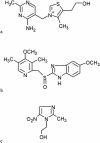Pyruvate decarboxylase, the target for omeprazole in metronidazole-resistant and iron-restricted Tritrichomonas foetus
- PMID: 15155220
- PMCID: PMC415579
- DOI: 10.1128/AAC.48.6.2185-2189.2004
Pyruvate decarboxylase, the target for omeprazole in metronidazole-resistant and iron-restricted Tritrichomonas foetus
Abstract
The substituted benzimidazole omeprazole, used for the treatment of human peptic ulcer disease, inhibits the growth of the metronidazole-resistant bovine pathogen Tritrichomonas foetus in vitro (MIC at which the growth of parasite cultures is inhibited by 50%, 22 microg/ml [63 microM]). The antitrichomonad activity appears to be due to the inhibition of pyruvate decarboxylase (PDC), which is the key enzyme responsible for ethanol production and which is strongly upregulated in metronidazole-resistant trichomonads. PDC was purified to homogeneity from the cytosol of metronidazole-resistant strain. The tetrameric enzyme of 60-kDa subunits is inhibited by omeprazole (50% inhibitory concentration, 16 microg/ml). Metronidazole-susceptible T. foetus, which expresses very little PDC, is only slightly affected. Omeprazole has the same inhibitory effect on T. foetus cells grown under iron-limited conditions. Similarly to metronidazole-resistant cells, T. foetus cells grown under iron-limited conditions have nonfunctional hydrogenosomal metabolism and rely on cytosolic PDC-mediated ethanol fermentation.
Figures



Similar articles
-
Loss of multiple hydrogenosomal proteins associated with organelle metabolism and high-level drug resistance in trichomonads.Exp Parasitol. 2001 Feb;97(2):102-10. doi: 10.1006/expr.2001.4587. Exp Parasitol. 2001. PMID: 11281707
-
Trichomonads, hydrogenosomes and drug resistance.Int J Parasitol. 1999 Feb;29(2):199-212. doi: 10.1016/s0020-7519(98)00155-6. Int J Parasitol. 1999. PMID: 10221623 Review.
-
Activity of disulfiram (bis(diethylthiocarbamoyl)disulphide) and ditiocarb (diethyldithiocarbamate) against metronidazole-sensitive and -resistant Trichomonas vaginalis and Tritrichomonas foetus.J Antimicrob Chemother. 1998 Dec;42(6):817-20. doi: 10.1093/jac/42.6.817. J Antimicrob Chemother. 1998. PMID: 10052908
-
Metabolic differences between metronidazole resistant and susceptible strains of Tritrichomonas foetus.Mol Biochem Parasitol. 1984 Apr;11:105-18. doi: 10.1016/0166-6851(84)90058-6. Mol Biochem Parasitol. 1984. PMID: 6379446
-
Molecular mechanisms underlying metronidazole resistance in trichomonads.Exp Parasitol. 1997 Nov;87(3):305-8. doi: 10.1006/expr.1997.4223. Exp Parasitol. 1997. PMID: 9371098 Review. No abstract available.
Cited by
-
The transferome of metabolic genes explored: analysis of the horizontal transfer of enzyme encoding genes in unicellular eukaryotes.Genome Biol. 2009;10(4):R36. doi: 10.1186/gb-2009-10-4-r36. Epub 2009 Apr 15. Genome Biol. 2009. PMID: 19368726 Free PMC article.
-
Transcriptomic identification of iron-regulated and iron-independent gene copies within the heavily duplicated Trichomonas vaginalis genome.Genome Biol Evol. 2012;4(10):1017-29. doi: 10.1093/gbe/evs078. Epub 2012 Sep 12. Genome Biol Evol. 2012. PMID: 22975721 Free PMC article.
-
Proton pump inhibitors are associated with a reduced likelihood for sexually transmitted diseases in women in the emergency department.Indian J Sex Transm Dis AIDS. 2017 Jan-Jun;38(1):60-64. doi: 10.4103/0253-7184.203438. Indian J Sex Transm Dis AIDS. 2017. PMID: 28442805 Free PMC article.
-
Biochemistry and evolution of anaerobic energy metabolism in eukaryotes.Microbiol Mol Biol Rev. 2012 Jun;76(2):444-95. doi: 10.1128/MMBR.05024-11. Microbiol Mol Biol Rev. 2012. PMID: 22688819 Free PMC article. Review.
-
Anti-infective properties of proton pump inhibitors: perspectives.Int Microbiol. 2022 Jan;25(1):217-222. doi: 10.1007/s10123-021-00203-y. Epub 2021 Sep 3. Int Microbiol. 2022. PMID: 34476634 Free PMC article.
References
-
- Čerkasovová, A., J. Čerkasov, and J. Kulda. 1984. Metabolic differences between metronidazole resistant and susceptible strains of Tritrichomonas foetus. Mol. Biochem. Parasitol. 11:105-118. - PubMed
-
- Cole, S. T., R. Brosch, J. Parkhill, T. Garnier, C. Churcher, D. Harris, S. V. Gordon, K. Eiglmeier, S. Gas, C. E. Barry III, F. Tekaia, K. Badcock, D. Basham, D. Brown, T. Chillingworth, R. Connor, R. Davies, K. Devlin, T. Feltwell, S. Gentles, N. Hamlin, S. Holroyd, T. Hornsby, K. Jagels, B. G. Barrell, et al. 1998. Deciphering the biology of Mycobacterium tuberculosis from the complete genome sequence. Nature 393:537-544. - PubMed
-
- Cole, S. T., K. Eiglmeier, J. Parkhill, K. D. James, N. R. Thomson, P. R. Wheeler, N. Honore, T. Garnier, C. Churcher, D. Harris, K. Mungall, D. Basham, D. Brown, T. Chillingworth, R. Connor, R. M. Davies, K. Devlin, S. Duthoy, T. Feltwell, A. Fraser, N. Hamlin, S. Holroyd, T. Hornsby, K. Jagels, C. Lacroix, J. Maclean, S. Moule, L. Murphy, K. Oliver, M. A. Quail, M. A. Rajandream, K. M. Rutherford, S. Rutter, K. Seeger, S. Simon, M. Simmonds, J. Skelton, R. Squares, S. Squares, K. Stevens, K. Taylor, S. Whitehead, J. R. Woodward, and B. G. Barrell. 2001. Massive gene decay in the leprosy bacillus. Nature 409:1007-1011. - PubMed
-
- Diamond, L. S. 1957. The establishment of various trichomonads of animals and man in axenic cultures. J. Parasitol. 43:488-490. - PubMed
Publication types
MeSH terms
Substances
LinkOut - more resources
Full Text Sources

